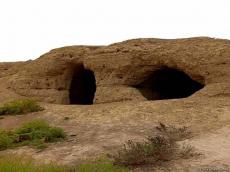|
|
TODAY.AZ / Society
Azerbaijan’s relics: Ancient caves discovered outside Sumgayit
27 October 2022 [12:59] - TODAY.AZ

By Azernews
By Sabina Mammadli
Traces of Azerbaijan’s fascinating rich history are scattered in its culture, literature, and architecture. Among other things, Azerbaijan’s ancient legacy lies in its famous stone drawings and archeological findings, which are evidence of life at the time. One such piece of history is numerous caves across the country.
On October 24, ancient caves were discovered near the settlement of Sumgayit station off the city of Sumgayit off Baku. Additionally, along with the caves, the remains of a caravanserai, a roadside inn where travelers (caravaners) could rest and recover from the day's journey, were also discovered.
Commenting on the findings, Spokesperson for the Azerbaijani State Service for the Preservation, Development, and Restoration of Cultural Heritage under the Culture Ministry Fariz Huseynli said that the Shabran Regional Department of the State Service is conducting research in the area.
"In general, comprehensive research is needed in this area. In the near future, it’s planned to conduct a joint inspection of the territory with archaeologists," he added.
Moreover, information has been spread in social media about the discovery.
Caves of various historical significance have been found all around Azerbaijan. In this way, the country’s famous Azykh Cave is one of the most ancient human habitats in the world.
The area of Azykh Cave, located in Khojavend District‘s Azykh village, is 800 square meters.
In 1960, the Palaeolithic Archaeological Expedition of the Azerbaijan National Academy of Sciences under the leadership of Mammadali Huseynov discovered the Azykh cave. In 1968, the low jaw bone of a human related to the Neanderthal type was found there. Studies of this fragment of the jaw showed that the age of the finding is 350,000-400,000 years, making it one of the oldest proto-human remains found in the world.
Scientists believe that the bone belongs to a girl about 18 years old. This age was considered old for that period, as the average life expectancy was 20-22 years.
During the Armenian occupation, illegal excavations had been carried out in the cave.
Azerbaijan’s Damjili cave is another archeological treasure with evidence of prehistoric human life in the region.
Damjili is the largest of the 30 caves of the Stone Age discovered on the territory of Gazakh District in the mid-1950s. Located at the foot of Avey Mount, its area is about 460 square meters and the height is four meters.
The cave, opened in 1953 by Azerbaijani scientists Mahammadali Huseynov and Russian scientist Zamyatin, is the first monument of the Stone Age discovered in Azerbaijan. It also has similarities with the ancient settlement of Goytepe of the Neolithic period, which is located in the neighboring Tovuz District.
A number of various stone tools, arrowheads, flint knives, and bones of animals were discovered in the cave during excavations. Traces of ochre were also found in the cave. The sediment layers, in which the ochre was found, are mixed with younger ones, which suggests that the use of ochre dates back to the Mousterian culture.
URL: http://www.today.az/news/society/227353.html
 Print version
Print version
Connect with us. Get latest news and updates.
See Also
- 29 November 2024 [18:15]
AZAL resumes flights to Tel Aviv - 26 November 2024 [17:42]
Young talents shine at TURKSOY Turkic World Youth Meeting - 26 November 2024 [17:21]
Media tour organized to Gala State Historical and Ethnographic Reserve - 24 November 2024 [20:15]
Rainless weather expected in Baku and Absheron Peninsula - 18 November 2024 [17:35]
Interpol President Ahmed Naser Al-Raisi praises Azerbaijan’s reforms & COP29 preparations - 09 November 2024 [20:06]
Azerbaijan Airlines launches direct flights to Maldives - 09 November 2024 [13:13]
15 routes temporarily suspended in Baku for COP29 - 06 November 2024 [17:50]
Azerbaijani carpet expert awarded in South Korea - 06 November 2024 [17:06]
Baku to host multimedia show dedicated to Mosfilm - 06 November 2024 [15:47]
Young Spectators Theater to present new solo performance
Most Popular
 "European Games" around the Caucasus: Armenia prepares for war
"European Games" around the Caucasus: Armenia prepares for war
 Baku-Paris political rifts deepen at COP29 over Macron's colonial allegations
Baku-Paris political rifts deepen at COP29 over Macron's colonial allegations
 Polish diplomat summoned over President Duda's visit to Armenian-Azerbaijani border region
Polish diplomat summoned over President Duda's visit to Armenian-Azerbaijani border region
 Azerbaijan, Japan discuss strengthening bilateral cooperation
Azerbaijan, Japan discuss strengthening bilateral cooperation
 Ruthless colonialism of France
Ruthless colonialism of France
 Japan, USA & Philippines to discuss joint maritime security
Japan, USA & Philippines to discuss joint maritime security
 Is Macron a Jew? Is Macron an Arab? Macron is a hypocrite!
Is Macron a Jew? Is Macron an Arab? Macron is a hypocrite!
